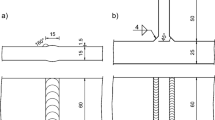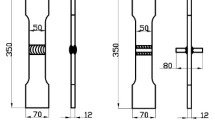We substantiate the efficiency of the high-frequency mechanical impact (HFMI) technology applied to increase the fatigue resistance of butt welded joints at the stage of production of steel structures or after their long-time operation in a zone of mild climate. The long-term influence of the atmosphere is simulated by holding the samples in a G4 chamber with controlled humidity at a temperature of 40°C and an air humidity of 98% for 1200 h. The fatigue tests were carried out on four batches of butt welded joints of 15KhSND steel: in the initial state and in the state hardened by HFMI after the holding in the G4 chamber: after 2·106 loading cycles and holding in the G4 chamber and after 2·106 loading cycles, holding in the G4 chamber, and subsequent treatment by HFMI. It is experimentally established that the HFMI technology can significantly increase the cyclic durability of butt welded joints of steel structures subjected to the influence of variable loads and drops of atmospheric pressure in the zone with mild climate in the course of their operation.




Similar content being viewed by others
References
T. Vuherer, P. Maruschak, and I. Samardžić, “Behavior of coarse grain heat affected zone (HAZ) during cycle loading,” Metalurgija, 51, No. 3, 301–304 (2012).
M. K. Kulekci and U. Esme, “Critical analysis of processes and apparatus for industrial surface peening technologies,” Int. J. Adv. Manufact. Technol., 74, No. 9, 1551–1565 (2014).
Y. Kudryavtsev, J. Kleiman, A. Lugovskoy, L. Lobanov, V. Knysh, O. Voitenko, and G. Prokopenko, “Rehabilitation and repair of welded elements and structures by ultrasonic peening,” Welding World, 51, Nos. 7–8, 47–53 (2007).
S. Abston, “The technology and applications of ultrasonic impact technology,” Australasian Welding J., 55, 20–21 (2010).
S. J. Madox, M. J. Dore, and S. D. Smith, “A case study of the use of ultrasonic peening for upgrading a welded steel structure,” Welding World, 55, No. 9, 56–67 (2011).
A. Abdullah, M. Malaki, and A. Eskandari, “Strength enhancement of the welded structures by ultrasonic peening,” Mater. Design, 38, 7–18 (2012).
F. B. Yalchiner and Z. Barsoum, “Life extension of welded structures using HFMI techniques – potential application to offshore structures,” Proc. Struct. Integrity, 5, 377–384 (2017).
F. Lefebvre, C. Peyrac, G. Elbel, C. Revilla-Gomez, C. Verdu, and J.-Y. Buffiere, “HFMI: understanding the mechanisms for fatigue life improvement and repair of welded structures,” Welding World, 61, No. 4, 789–799 (2017).
L. M. Lobanov, V. I. Kirian, V. V. Knysh, and G. I. Prokopenko, “Improvement of fatigue resistance of welded joints in metal structures by high-frequency mechanical peening (Review),” Paton Welding J., No. 9, 2–8 (2006).
M. Malaki and H. Ding, “A review of ultrasonic peening treatment,” Mater. Design, 87, 1072–1086 (2015).
M. Daavari and S. A. Sadough Vanini, “Corrosion fatigue enhancement of welded steel pipes by ultrasonic impact treatment,” Mater. Letters, 139, 462–466 (2015).
W. Gao, D. Wang, F. Cheng, C. Deng, Y. Liu, and W. Xu, “Enhancement of the fatigue strength of underwater wet welds by grinding and ultrasonic impact treatment,” J. Mater. Proc. Technol., 223, 305–312 (2015).
V. V. Knysh, S. A. Solovei, A. A. Kadyshev, L. I. Nyrkova, and S. A. Osadchuk, “Influence of high-frequency peening on the corrosion fatigue of welded joints,” Fiz.-Khim. Mekh. Mater., 53, No. 1, 12–17 (2017); English translation : Mater. Sci., 53, No. 1, 7–13 (2017).
B. Ahmad and M. E. Fitzpatrick, “Effect of ultrasonic peening and accelerated corrosion exposure on residual stress distribution in welded marine steel,” Metallurg. Mat. Transact. A, 46, 1214–1226 (2015).
Y. Fan, X. Zhao, and Y. Liu, “Research on fatigue behavior of the flash welded joint enhanced by ultrasonic peening treatment,” Mater. Design, 94, 515–522 (2016).
Author information
Authors and Affiliations
Corresponding author
Additional information
Translated from Fizyko-Khimichna Mekhanika Materialiv, Vol. 54, No. 3, pp. 120–127, May–June, 2018.
Rights and permissions
About this article
Cite this article
Knysh, V.V., Solovei, S.O., Osadchuk, S.O. et al. Influence of Hardening by High-Frequency Mechanical Impacts of Butt Welded Joints Made of 15KhSND Steel on Their Atmospheric Corrosion and Fatigue Fracture Resistance. Mater Sci 54, 421–429 (2018). https://doi.org/10.1007/s11003-018-0201-4
Received:
Published:
Issue Date:
DOI: https://doi.org/10.1007/s11003-018-0201-4




